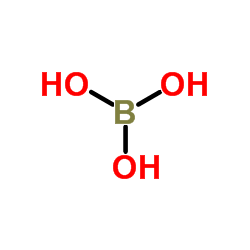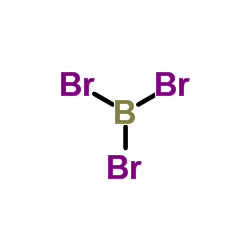14075-53-7
| 中文名 | 氟硼酸钾 |
|---|---|
| 英文名 | Potassium tetrafluoroborate |
| 英文别名 |
Borate(1-), tetrafluoro-, potassium (1:1)
potassium fluoborate benzyl alcohol xanthate potassium salt MFCD00011395 potassium benzylxanthate CARBONIC ACID,DITHIO-,O-BENZYL ESTER,POTASSIUM SALT Potassium borofluoride Potassium tetrafluoroborate Potassium O-benzyl dithiocarbonate potassium fluoroborate dithiocarbonic acid O-benzyl ester,potassium-salt EINECS 237-928-2 Potassium O-benzyl xanthate Dithiokohlensaeure-O-benzylester,Kalium-Salz potassium benzyl dithiocarbonate Xanthic acid,benzyl-,potassium salt potassiumm benzyldithiocarbonate Potassium Fluorborate (KBF4) |
| 密度 | 2.505 g/mL at 25 °C(lit.) |
|---|---|
| 沸点 | 960.85 (310 torr) |
| 熔点 | 530 °C(lit.) |
| 分子式 | BF4K |
| 分子量 | 125.903 |
| 精确质量 | 125.966629 |
| LogP | 1.30000 |
| 外观性状 | 淡灰色结晶粉末 |
| 折射率 | 1.3245 |
| 储存条件 | 1.应贮存在阴凉、干燥的库房中。包装密闭保存,防止包装破损。运输时要防雨淋,防日光曝晒,注意防潮。 |
| 稳定性 | 1.常温常压下稳定 2.避免的物料:水分/潮湿。微溶于水及热乙醇,不溶于冷乙醇。在熔融时开始分解。能被硫酸等强酸分解生成三氟化硼。与碱金属碳酸盐熔融时生成氟化物和硼酸盐。有毒! 白色粉末状或凝胶状结晶体,无吸湿性,味苦,从水溶液中结晶可得六面棱形晶体。微溶于水及热乙醇中,不溶于冷乙醇中。熔点530℃,在熔融时开始分解。能被硫酸等强酸分解生成三氟化硼。与碱金属碳酸盐熔融时,生成氟化物和硼酸盐。氟硼酸钾密度2.498g/cm3。有毒。大鼠腹腔LD50240mg/kg。 3.能被强酸分解为三氟化硼。与碱金属的碳酸盐共熔生成氟化物和硼酸盐。有毒。 |
| 水溶解性 | 4.4 g/L (20 ºC) |
| 分子结构 | 1、摩尔折射率:无可用的 2、摩尔体积(cm3/mol):无可用的 3、等张比容(90.2K):无可用的 4、表面张力(dyne/cm):无可用的 5、介电常数:无可用的 6、极化率(10-24cm3):无可用的 7、单一同位素质量:125.966626 Da 8、标称质量:126 Da 9、平均质量:125.9029 Da |
| 计算化学 | 1.疏水参数计算参考值(XlogP):无 2.氢键供体数量:0 3.氢键受体数量:5 4.可旋转化学键数量:0 5.互变异构体数量:无 6.拓扑分子极性表面积0 7.重原子数量:6 8.表面电荷:0 9.复杂度:23 10.同位素原子数量:0 11.确定原子立构中心数量:0 12.不确定原子立构中心数量:0 13.确定化学键立构中心数量:0 14.不确定化学键立构中心数量:0 15.共价键单元数量:2 |
| 更多 | 1. 性状:白色粉末或凝胶状结晶。无吸湿性。味苦。 2. 密度(g/mL,25/4℃):2.5 3. 相对蒸汽密度(g/mL,空气=1):未确定 4. 熔点(ºC):530 5. 沸点(ºC,常压):未确定 6. 沸点(ºC,5.2kPa):未确定 7. 折射率:未确定 8. 闪点(ºC):未确定 9. 比旋光度(º):未确定 10. 自燃点或引燃温度(ºC):不适用的 11. 蒸气压(kPa,25ºC):未确定 12. 饱和蒸气压(kPa,60ºC):未确定 13. 燃烧热(KJ/mol):未确定 14. 临界温度(ºC):未确定 15. 临界压力(KPa):未确定 16. 油水(辛醇/水)分配系数的对数值:未确定 17. 爆炸上限(%,V/V):未确定 18. 爆炸下限(%,V/V):未确定 19. 溶解性:微溶于水、热醇和乙醇,不溶于碱溶液。 |
Synonym:Potassium borofluoride Section 2 - COMPOSITION, INFORMATION ON INGREDIENTS
Risk Phrases: 34 Section 3 - HAZARDS IDENTIFICATION EMERGENCY OVERVIEW
Causes burns.Corrosive.Moisture sensitive. Potential Health Effects Eye: Contact with eyes may cause severe irritation, and possible eye burns. Skin: May cause severe irritation and possible burns. Ingestion: May cause severe and permanent damage to the digestive tract. Causes gastrointestinal tract burns. Inhalation: Irritation may lead to chemical pneumonitis and pulmonary edema. Causes chemical burns to the respiratory tract. May cause abdominal pain, nausea, vomiting, and inflammation of the gums and mouth. Chronic: No information found. Section 4 - FIRST AID MEASURES Eyes: Get medical aid immediately. Do NOT allow victim to rub eyes or keep eyes closed. Extensive irrigation with water is required (at least 30 minutes). Skin: Get medical aid immediately. Immediately flush skin with plenty of water for at least 15 minutes while removing contaminated clothing and shoes. Wash clothing before reuse. Destroy contaminated shoes. Ingestion: Do not induce vomiting. If victim is conscious and alert, give 2-4 cupfuls of milk or water. Never give anything by mouth to an unconscious person. Get medical aid immediately. Inhalation: Get medical aid immediately. Remove from exposure and move to fresh air immediately. If breathing is difficult, give oxygen. Do NOT use mouth-to-mouth resuscitation. If breathing has ceased apply artificial respiration using oxygen and a suitable mechanical device such as a bag and a mask. Notes to Physician: Section 5 - FIRE FIGHTING MEASURES General Information: As in any fire, wear a self-contained breathing apparatus in pressure-demand, MSHA/NIOSH (approved or equivalent), and full protective gear. During a fire, irritating and highly toxic gases may be generated by thermal decomposition or combustion. Extinguishing Media: Use water spray, dry chemical, carbon dioxide, or chemical foam. Use agent most appropriate to extinguish fire. Do NOT get water inside containers. Section 6 - ACCIDENTAL RELEASE MEASURES General Information: Use proper personal protective equipment as indicated in Section 8. Spills/Leaks: Vacuum or sweep up material and place into a suitable disposal container. Clean up spills immediately, observing precautions in the Protective Equipment section. Avoid generating dusty conditions. Provide ventilation. Do not get water inside containers. Section 7 - HANDLING and STORAGE Handling: Minimize dust generation and accumulation. Do not breathe dust, vapor, mist, or gas. Keep container tightly closed. Do not get on skin or in eyes. Do not ingest or inhale. Use with adequate ventilation. Do not allow contact with water. Use only in a chemical fume hood. Discard contaminated shoes. Keep from contact with moist air and steam. Storage: Store in a cool, dry place. Keep container closed when not in use. Keep under a nitrogen blanket. Corrosives area. Store protected from moisture. Section 8 - EXPOSURE CONTROLS, PERSONAL PROTECTION Engineering Controls: Facilities storing or utilizing this material should be equipped with an eyewash facility and a safety shower. Use adequate ventilation to keep airborne concentrations low. Exposure Limits CAS# 14075-53-7: Personal Protective Equipment Eyes: Wear appropriate protective eyeglasses or chemical safety goggles as described by OSHA's eye and face protection regulations in 29 CFR 1910.133 or European Standard EN166. Skin: Wear appropriate protective gloves to prevent skin exposure. Clothing: Wear appropriate protective clothing to minimize contact with skin. Respirators: A respiratory protection program that meets OSHA's 29 CFR 1910.134 and ANSI Z88.2 requirements or European Standard EN 149 must be followed whenever workplace conditions warrant respirator use. Section 9 - PHYSICAL AND CHEMICAL PROPERTIES Physical State: Crystalline powder Color: white Odor: Not available. pH: Not available. Vapor Pressure: Not available. Viscosity: Not available. Boiling Point: Not available. Freezing/Melting Point: 530 deg C Autoignition Temperature: Not applicable. Flash Point: Not applicable. Explosion Limits, lower: Not available. Explosion Limits, upper: Not available. Decomposition Temperature: Solubility in water: slightly soluble in boiling alcohol Specific Gravity/Density: 2.5050g/cm3 Molecular Formula: BF4K Molecular Weight: 125.91 Section 10 - STABILITY AND REACTIVITY Chemical Stability: Stable at room temperature in closed containers under normal storage and handling conditions. Conditions to Avoid: Dust generation, moisture, excess heat, exposure to moist air or water. Incompatibilities with Other Materials: Strong acids, strong bases, strong oxidizing agents, strong reducing agents. Hazardous Decomposition Products: Irritating and toxic fumes and gases, hydrogen fluoride gas. Hazardous Polymerization: Has not been reported. Section 11 - TOXICOLOGICAL INFORMATION RTECS#: CAS# 14075-53-7: ED2800000 LD50/LC50: Not available. Carcinogenicity: Potassium Tetrafluoroborate, C.P. - Not listed by ACGIH, IARC, or NTP. Other: See actual entry in RTECS for complete information. Section 12 - ECOLOGICAL INFORMATION Section 13 - DISPOSAL CONSIDERATIONS Dispose of in a manner consistent with federal, state, and local regulations. Section 14 - TRANSPORT INFORMATION IATA Shipping Name: CORROSIVE SOLID, N.O.S.* Hazard Class: 8 UN Number: 1759 Packing Group: II IMO Shipping Name: CORROSIVE SOLID, N.O.S. Hazard Class: 8 UN Number: 1759 Packing Group: II RID/ADR Shipping Name: CORROSIVE SOLID, N.O.S. Hazard Class: 8 UN Number: 1759 Packing group: II Section 15 - REGULATORY INFORMATION European/International Regulations European Labeling in Accordance with EC Directives Hazard Symbols: C Risk Phrases: R 34 Causes burns. Safety Phrases: S 25 Avoid contact with eyes. S 36/37/39 Wear suitable protective clothing, gloves and eye/face protection. S 45 In case of accident or if you feel unwell, seek medical advice immediately (show the label where possible). WGK (Water Danger/Protection) CAS# 14075-53-7: 1 Canada CAS# 14075-53-7 is listed on Canada's DSL List. CAS# 14075-53-7 is not listed on Canada's Ingredient Disclosure List. US FEDERAL TSCA CAS# 14075-53-7 is listed on the TSCA inventory. SECTION 16 - ADDITIONAL INFORMATION N/A |
|
毒理学数据: 1、急性毒性:主要的刺激性影响: 在皮肤上面:刺激皮肤和粘膜; 在眼睛上面:刺激的影响;没有已知的敏化影响。 生态学数据: 通常对水体是稍微有害的,不要将未稀释或大量产品接触地下水,水道或污水系统,未经政府许可勿将材料排入周围环境。 CHEMICAL IDENTIFICATION
HEALTH HAZARD DATAACUTE TOXICITY DATA
|
| 个人防护装备 | Eyeshields;Gloves;type N95 (US);type P1 (EN143) respirator filter |
|---|---|
| 危害码 (欧洲) | C:Corrosive |
| 风险声明 (欧洲) | R34 |
| 安全声明 (欧洲) | S37/39-S26-S45-S36/37/39 |
| 危险品运输编码 | 3260 |
| WGK德国 | 1 |
| RTECS号 | ED2800000 |
| 包装等级 | I; II; III |
| 海关编码 | 2826909090 |
| 上游产品 10 | |
|---|---|
| 下游产品 7 | |
| 海关编码 | 2826909090 |
|---|






















